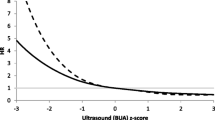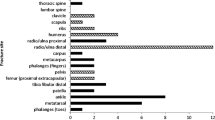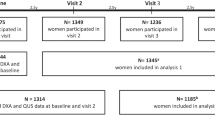Abstract
The Saunders County Bone Quality Study was designed to determine the feasibility of ultrasonic bone measurement, at the patella, as a predictor of low-trauma fractures in a runal population-based study. At the first visit of this 4-year longitudinal study, anthropometric and clinical measurements and medical, surgical, and fracture histories were obtained for the 1428 participants (899 women and 529 men). Explored risk factors for low-trauma fractures included age, sex, calcium intake, alcohol and caffeine ingestion, tobacco use, body mass and grip strength, age of menopause, estrogen replacement therapy, propensity to fall, distal radius and ulna bone mineral content, and bone density. Forward multivariate logistic regression analysis showed that lower ultrasound values are more consistently associated with reported low-trauma appendicular fractures than the commonly reported forearm absorptiometry measures of radius mineral content and density. When ultrasound, age, and the extra skeletal risk factors were included in an additional multivariate model, only age and ultrasound were significantly associated with appendicular fracture history in women (P=0.0003), whereas only ultrasound was associated in the men (P=0.001). We conclude that ultrasound is a better measure of association with reported low-trauma fractures than the commonly reported forearm SPA measures. Even after adjustment for many of the extra skeletal risk factors, low AVU is highly associated with low-trauma fracture status for both women and men.
Similar content being viewed by others
References
Osteoporosis research, education and health promotion (1991) National Institute of Arthritis and Musculoskeletal and Skin Disease, Washington, DC: U.S. Government Printing Office
Lindsay R (1993) Prevention of osteoporosis. In: Favus MJ (ed) Primer on metabolic bone diseases and disorders of mineral metabolism 2nd ed. Raven Press, New York, pp 240–245
Heaney RP (1993) Is there a role for bone quality in fragility fractures? Calcif Tissue Int 53:S3-S6
Brandenburger GH (1993) Clinical determination of bone quality: Is ultrasound an answer? Calcif Tissue Int 53:S151-S156
Turner CH, Peacock M, Schaefer CA, Timmerman L, Johnson CC (1994) Ultrasonic measurements discriminate hip fractures independently of bone mass (abstract). J Bone Miner Res; (suppl 9) 1:S157
Stegman MR, Heaney RP, Recker RR, Travers-Gustafson D, Leist J (1994) Velocity of ultrasound and its association with fracture history in a rural population. Am J Epidemiol 139:1027–1034
Heaney RP, Avioli LV, Chesnut CH, Lappe J, Recker RR, Brandenburg GH (1989) Osteoporotic bone fragility. Detection by ultrasound transmission velocity. JAMA 261:2986–2990
Seeley DG, Browner WS, Nevitt MC, Genant HK, Scott JC, Cummings SR (1991) Which fractures are associated with low appendicular bone mass in elderly women? Ann Intern Med 115:837–842
Heaney RP, Avioli LV, Chesnutill CH, Lappe J, Recker RR, Brandenburger GH (1995) Ultrasound velocity through bone predicts incident vertebral deformity. J Bone Miner Res 10:341–345
Block G, Dresser CM, Hartman AM, Carroll MD (1985) Nutrient sources in the American diet: quantitative data from the NHANES II survey I. Vitamins and minerals. Am J Epidemiol 122:13–26
Kalt BC (ed) SAS Applications Guide (1967) SAS Institute Inc, Cary, NC, pp 228–229
Kahn HA, Sempos CT (1989) Statistical methods in epidemiology. Oxford University Press, New York
Stegman MR, Heaney RP, Travers-Gustafson D, Leist J. (1995) Cortical ultrasound velocity as an indicator of bone status. Osteoporosis Int (in press)
Hosmer DW, Lemeshow S (1989) Applied logistic regression. John Wiley & Sons, New York
Slemenda CW, Hui SL, Longcope C, Wellman H, Johnston CC (1990) Predictors of bone mass in perimenopausal women. Ann Intern Med 112:96–101
Ooms ME, Lips O, VanLingen A, Valkenburg HA (1993) Determinants of bone mineral density and risk factors for osteoporosis in healthy elderly women. J Bone Miner Res 8:669–676
Kritz-Silverstein D, Barrett-Connor E (1994) Grip strength and bone mineral density in older women. J Bone Miner Res 9:45–51
Mansen MA (1994) Assessment of age and risk factors on bone density and bone turnover in healthy premenopausal women. Osteoporosis Int 4:123–128
VanDaele PLA, Burger H, Algra D, Hofman A, Grobbee DE, Birkenhager JD, Pols HAP (1994) Age-associated changes in ultrasound measurements of the calcaneus in men and women: the Rotterdam Study. J Bone Miner Res 9:1751–1759
Huntly J, Brock DB, Ostfeld AM, Taylor JO, Wallace RB (1986) Established populations for epidemiologic studies of the elderly. In: Lafferty ME (ed) Resource data book, NIH Publ No 86-2443. National Institutes of Health-National Institute on Aging
Kannus P, Jarvinen M, Sievanen H, Jarvinen TAH, Oja P, Vuori I (1994) Reduced bone mineral density in men with a previous femur fracture. J Bone Miner Res 9:1729–1736
Cleghorn DB, Polley KJ, Nordin BDC (1992) Fracture rates calculated from fracture histories in normal postmenopausal women. J Epidemiol Comm Health 46:133–135
Author information
Authors and Affiliations
Rights and permissions
About this article
Cite this article
Travers-Gustafson, D., Stegman, M.R., Heaney, R.P. et al. Ultrasound, densitometry, and extraskeletal appendicular fracture risk factors: A cross-sectional report on The Saunders County Bone Quality Study. Calcif Tissue Int 57, 267–271 (1995). https://doi.org/10.1007/BF00298881
Received:
Accepted:
Issue Date:
DOI: https://doi.org/10.1007/BF00298881




